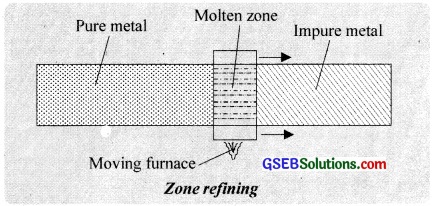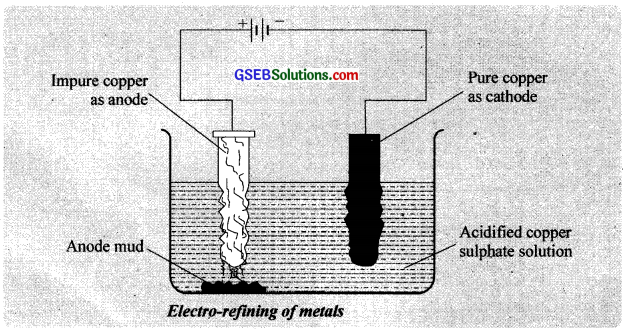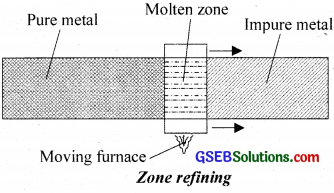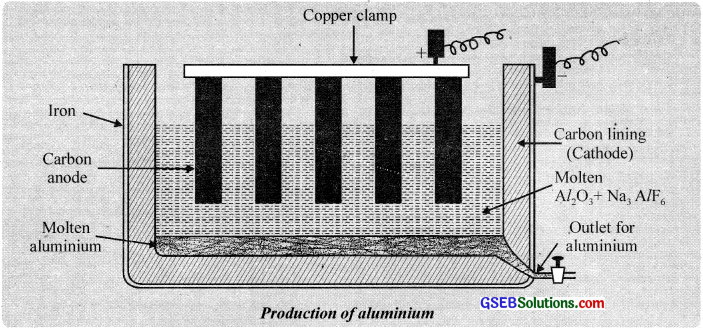Gujarat Board GSEB Textbook Solutions Class 12 Chemistry Chapter 6 General Principles and Processes of Isolation of Elements Textbook Questions and Answers, Additional Important Questions, Notes Pdf.
Gujarat Board Textbook Solutions Class 12 Chemistry Chapter 6 General Principles and Processes of Isolation of Elements
GSEB Class 12 Chemistry General Principles and Processes of Isolation of Elements InText Questions and Answers
Question 1.
Which of the ores mentioned in Table 6.1 can be concentrated by magnetic separation method?
Answer:
Magnetic ores are separated from non-magnetic impurities by the magnetic separation method. For example, magnetic (anion ore) is separated from non-magnetic silica and other impurities by this method.
![]()
Question 2.
What is the significance of leaching in the extraction of aluminium?
Answer:
Leaching is used to remove insoluble impurities like silica, iron oxides, etc. Alumina becomes soluble in NaOH while the impurities do not.
Question 3.
The reaction, Cr2O3 + 2 Al → Al2O3 + 2Cr (∆G° = – 421 kJ) is thermodynamically feasible as is apparent from the Gibbs energy value. Why does it not take place at room temperature?
Answer:
All the reactants and products are solid at room temperature. Therefore, the reaction does not occur at room temperature. At high temperatures, reactants melt and react.
![]()
Question 4.
Is it true that under certain conditions, Mg can reduce Al2O3 and Al can reduce MgO? What are those conditions?
Answer:
Yes. From the Ellingham diagram, it is found that the plots of Al and Mg cross each other at 1350°C. Thus, below 1350°C Mg can reduce Al2O3 and above 1350°C Al can reduce MgO.
GSEB Class 12 Chemistry General Principles and Processes of Isolation of Elements Text Book Questions and Answers
Question 1.
Copper can be extracted by hydrometallurgy but not zinc. Explain?
Answer:
Zinc is a highly reactive metal, it may not be possible to replace it from a solution of ZnSO4 so easily.
Question 2.
What is the role of depressant in froth floatation process?
Answer:
The role of depressant is to prevent one type of sulphide ore particles from forming the froth with air bubbles. NaCN is used as a depressant to separate lead sulphide (PbS) ore from zinc sulphide (ZnS) ore. NaCN forms a zinc complex, Na[Zn(CN)4] on the surface of ZnS thereby preventing it from the formation of the froath.
![]()
Question 3.
Why is the extraction of copper from pyrites more difficult than that from its oxide ore through, reduction?
Answer:
The Gibbs energies of formation of most sulphides are greater than that for CS2. In fact, CS2 is an endothermic compound. Hence it is common practice to roast sulphide ores to corresponding oxides prior to reduction.
Question 4.
Explain:
- Zone refining
- Column chromatography.
Answer:
Zone refining:
Molten zone This method is applied to produce metals in an extremely high degree of purity. The method is based on the fact that melting point of a substance is lowered by the presence of impurities. Consequently. when an impure metal in molten state is cooled, crystals of pure metals are solidified first and the impurities Moving furnace will remain in the molten part.
The impure metal, in the form of a rod, is melted over a very narrow region at one end. The molten region is transferred to the other end slowly by moving the source of heat. The impurities collected in the molten part are swept at one end of the metal and are discarded. Pure Ge, Si, Ga etc used as semiconductors are refined by this method.

Chromatographic methods:
This method is used for the purification of the elements which are available in minute quantities and the impurities are not very different in chemical properties from the element to be purified. This method is based on the principle that different components of a mixture arc differently adsorbed on an adsorbent.
In column chromatography, an adsorbent (e.g. silica gel, Al2O3 etc.) is packed in a glass column. The mixture to be separated and purified, taken in a suitable solvent, is applied on the top of the column. The components of the mixture get adsorbed on the column. They are then eluted out with a suitable eluant (solvent). The weakly adsorbed component is eluted first followed by the more strongly adsorbed and so on.
![]()
Question 5.
Out of C and CO, which is a better reducing agent at 673 K?
Answer:
From thermodynamic considerations, below 673 K both C and CO can act as reducing agents. However, CO can be more easily oxidised to CO2, than carbon to CO2. Therefore below 673 K, CO is a better reducing agent than C.
Question 6.
Name the common elements present in the anode mud in electrolytic refining of copper. Why are they so present?
Answer:
The common elements present in the anode mud are Ag, Au, Pt, Sb, Se etc. These elements are less reactive and not affected by CuSO4 and H2SO4 solution and hence, settle down under anode as anode mud.
Question 7.
Write down the reactions taking place in different zones in the blast furnace during the extraction of iron?
Answer:
In combustion zone:
C + O2 → CO2 + heat
In fusion zone:
CO2 + C → 2CO – Heat
In slag formation zone:
CaCO3 → CaO + CO2
CaO + SiO2 → CaSiO3
In reduction zone:
Fe2O3 + CO → 2FeO + CO2
FeO + CO → Fe + CO2
![]()
Question 8.
Write chemical reactions taking place in the extraction of zinc from zinc blende?
Answer:
Zinc blende or Sphalerite (ZnS). Calamine (ZnCO3) and Zincite (ZnO) are the chief ores of zinc The Zn – ZnO curve js much above C – CO curve at temperature above 1000K in Elíingham diagram. Thus, coke reduces ZnO above this temperature.
The powdered ore is concentrated first by gravity separation process and then by froth floatation process. The concentrated ore is roasted at about 1173 K. The oxide of zinc thus obtained is made into brickettes with coke and clay and heated by producer gas in vertical retorts at 1673 K.
![]()
Zinc nietal has low boiling point (1180 K) and here it is purified by distillation. The Zn metal is distilled off and is collect by rapid cooling. The metal may be purified by fractional distillation.
Uses of Zinc:
- For galvanisation of iron sheets, because zinc ¡s resistant to atmospheric corrosion due to the formation of basic carbonate on its surface.
- As a constituent of many alloys. e.g. brass (Cu – 60%, Zn – 40%) and German silver (Cu – 25 – 30%. Zn – 25 – 30%, Ni – 40 – 50%) .
- Zinc dust is used as a reducing agent in the manufacture of oldye-stuffs, paints etc.
- in the extraction of silver and gold by cyanide process.
- As a cathode in dry cells.
Question 9.
State the role of silica in the metallurgy of copper?
Answer:
Silica removes Fe2O3 remaining in the matte by forming silicate, FeSiO3.
![]()
Question 10.
What is meant by the term “chromatography”?
Answer:
Chromatography is a technique for the separation and purification based on the difference in the adsorbing tendencies of the metal and its impurities on a suitable adsorbent. It is based on the principle that different compounds of a mixture are differently adsorbed on an adsorbent. The term is originally derived from the Greek word ‘Chroma’ meaning colour and ‘graphy’ for writing because it is first used to colour plant pigments.
Question 11.
What criterion is followed for the selection of the stationary phase in chromatography?
Answer:
The impurities are more strongly adsorbed or are more soluble in the stationary phase than element to be purified. Under these conditions, when the column is extracted, the impurities will be retained by the stationary phase while the pure component is easily eluted.
Question 12.
Describe a method for refining nickel?
Answer:
Mond process: Nickel is refined by this method. Impure nickel is heated in a current of CO at 330-350 K. Volatile nickel carbonyl Ni(CO)4 is formed while the impurities remain behind. Nickel carbonyl is now heated to 450-470 K. It decomposes to give pure nickel.

![]()
Question 13.
How can you separate alumina from silica in a bauxite ore associated with silica? Give equations, if any?
Answer:
This is a chemical method and in this method the ore is treated with a suitable reagent which dissolves the ore but not the impurities. The impurities left undissolved, are removed by filtration. The ore is recovered from the solution by a suitable chemical method. Some important examples are described below:
(a) Bauxite (Al2O3. 2H2O):
The powdered ore is treated with Conc. NaOH solution, then Al become soluble in the form of Na[Al(OH)4]. The impurities are removed by filtration and the filtrate is neutralised by passing CO2 gas when the hydrated Al2O3 is precipitated. The precipitate on ignition gives Al2O3.
Al2O3 + 3H2O +2 NaOH → 2 Na[Al (OH4)]
2 Na[Al(OH4)] + CO2 → Al2O3xH2O + 2NaHCO3
![]()
(b) Silver ores and gold present in rocks are leached with a dilute solution of sodium or potassium cyanide.
Ag2S + 4NaCN → 2Na[Ag(CN2)]+ Na2S
4Au + 8KCN + 2H2O + O2 → 4K[Au(CN2)] + 4KOH
The metal is then recovered by adding zinc scrap to the solution.
2Na[Ag(CN)2] + Zn → 2Ag + Na2[Zn(CN)4]
2K[Au(CN)2] + Zn → 2Au + K2[Zn(CN)4]
Question 14.
Giving examples, differentiate between ‘roasting’ and ‘calcination’?
Answer:
Difference between Roasting and Calcination:
Roasting: Heating ore in the presence of air below its melting point. This is generally done for sulphide ore.
Calcination: Heating ore either in the presence or limited supply of air below its melting point. This is generally done for carbonate ore.
Question 15.
How is ‘cast iron’ different from ‘pig iron’?
Answer:
Cast iron is made from pig iron by melting pig iron with scrap iron and coke. It has slightly lower carbon content (> 3%) than pig iron (> 4% C).
![]()
Question 16.
Differentiate between “minerals” and “ores”?
Answer:
Differences between Minerals and Ores:
Minerals:
- Compounds of metals which contain less amount of metal and are found in in the earth’s crust with impurities are called a mineral.
- It is difficult to obtain metals in pure form from minerals.
- Example: Mica, Feldspar, Limonite etc.
Ores:
- Compounds of metals which contain a sufficient amount of metal are known as ores.
- Metals can be obtained easily in pure form from the ores.
- Example: Ores of Aluminium, Cryolite, Bauxite, Alunite etc.
Question 17.
Why copper matte is put in silica lined converter?
Answer:
During roasting, copper pyrites are converted into a mixture of FeO and Cu2O.

2 FeS + 3O2 → 2FeO + 2SO2
To remove FeO (basic), silica (acidic flux) is added during smelting. FeO combines with SiO2 to form slag.
FeO + SiO2 → FeSiO3
Silica acts as a flux to remove FeO as slag in the metallurgy of copper.
Question 18.
What is the role of cryolite in the metallurgy of aluminium?
Answer:
Cryolite serves the following two purposes:
- It makes alumina a good conductor of electricity.
- It lowers the fusion temperature of electrolytes.
![]()
Question 19.
Why is zinc not extracted from zinc oxide through reduction using CO?
Answer:
In Ellingham diagram, the curve for the oxidation of CO to CO2 lies above the curve for the oxidation of Zn. Therefore, CO cannot reduce ZnO to Zn. On the other hand, the curve for the oxidation of C to CO, lies below the curve for the oxidation of Zn at temperature 1120K or above. Therefore, ‘C’ can be used to reduce ZnO at 1120K or above this temperature.
Question 20.
The value of ∆fG° for the formation of Cr2O3 is -540 kJmol-1 and that of Al2O3 is -827 kJmol-1. Is the reduction of Cr2O3 possible with Al?
Answer:
Yes.
2Al + \(\frac{3}{2}\)O2 → Al2O3 ∆rG° = -827 kJ mol-1
2Cr + \(\frac{3}{2}\)O2 → Cr2O3 ∆rG° = -540 kJ mol-1
Hence Cr2O3 + 2Al → Al2O3 + 2Cr
-827 – (-540) = -287 kJ mol-1
![]()
Question 21.
Out of C and CO, which is a better reducing agent for ZnO?
Answer:
Gibbs energy of formation (∆fG°) of CO from C becomes lower at temperature above 1120 K while that of CO2 from C becomes lower above 1323 K than ∆fG° of ZnO. However, ∆fG° of CO2 from CO is always higher than that of ZnO. Therefore, C can reduce ZnO to Zn, but not CO. Thus, out of C and CO, C is a better reducing agent than CO for ZnO.
Question 22.
Name the processes from which chlorine is obtained as a by-product. What will happen if an aqueous solution of NaCl is subjected to electrolysis?
Answer:
The standard free energy of formation (∆rG°) of CO2 from CO is higher than that of the formation of ZnO from Zn. Therefore, CO cannot be used to reduce ZnO to Zn.
Question 23.
What is the role of a graphite rod in the electrometallurgy of aluminium?
Answer:
Graphite rods act as anode and get burnt away as CO and CO2 during the process of electrolysis. In other words, graphite rods prevent the liberation of O2 at the anode which may otherwise oxidise some of the liberated Al back to Al2O3.
![]()
Question 24.
Outline the principles of refining of metals by the following methods:
- Zone refining
- Electrolytic refining
- Vapour phase refining
Answer:
Zone refining:
This method is applied to produce metals in an extremely high degree of purity. The method is based on the fact that melting point of a substance is lowered by the presence of impurities. Consequently, when an impure metal in the molten state is cooled, crystals of pure metals are solidified first and the impurities Moving furnace will remain in the molten part.
The impure metal, in the form of a rod, is melted over a very narrow region at one end. The molten region is transferred to the other end síowly by moving the source of heat. The impurities collected in the molten part are swept at one end of the metal and are discarded. Pure Ge. Si, Ga etc used as semiconductors are refined by this method.

Electrolytic refining:
This method is applicable for the púrification of Cu, Sn, Pb, Zn, Mn, Cr, Ni, Ag and Au. The impure metal is used as anode and pure metal is used as cathode. The electrolyte is a solution of a suitable salt of the metal. On passing electric current, the pure metal is deposited on the cathode. The solid impurities fall to the bottom of the cell and are recovered as anode mud. The soluble impurities go to the solution. For the purification of copper, the electrolyte used is a solution of copper sulphate and the electrode reactions are
Anode:
Cu → Cu2+ + 2e–
Cathode:
Cu2+ + 2e– → Cu

Vapour phase refining:
(a) Mond’s Process:
This process is useful for refining nickel. The impure metal is heated with CO at 60° – 80° C. The metal reacts with CO to form gaseous metal carbonyls leaving behind solid impurities. The pure metal is recovered from the metal carbonyl by heating the gas at 180 – 200°C.

(b) van Arkel Process:
This method is based upon the thermal decomposition of a metal compound and is applicable to the purification of Zr, Hf, Ti and Th. The impure metal is heated in a limited amount of iodine in an evacuated glass apparatus. The gaseous metal iodide is decomposed on contact with a hot tungsten filament and pure metal is deposited on the filament.

![]()
Question 25.
Predict conditions under which Al might be expected to reduce MgO?
Answer:
Above 1665 K, Al can reduce MgO to Mg.
GSEB Class 12 Chemistry General Principles and Processes of Isolation of Elements Additional Important Questions and Answers
Question 1.
One of the steps in metallurgy is concentration of ores. Majority of the concentration techniques are physical in nature. But there is a chemical method of concentration of ores.
- Give a metal ore which can be concentrated by chemical methods.
- Explain the concentration method of that metal ore with suitable equations.
- Also explain the terms calcination and roasting.
Answer:
1. Bauxite, the ore of aluminium is concentrated by chemical method. This method is known as leaching.
2. Bauxite ore is purified by leaching. (Baeyer’s process)
Powdered bauxite is digested with concentrated caustic soda (NaOH) solution under pressure at about 473 – 523 K, Al2O3 dissolves as NaAlO2.
The solid impurities like Fe2O3, SiO2 etc are separated by filtration. The filtrate containing sodium aluminate is hydrolysed with water to precipitate Al(OH)3 on cooling. The precipitate is filtered, washed, dried and then calcined at about 1473 K to get alumina (Al2O3).
Al2O3 + 6NaOH → 2Na3AlO3 + 3H2O
Na3AlO3 + 3H2O → Al(OH)3 + 3 NaOH
![]()
3. Calcination is the process of heating the concentrated ore strongly in the absence of air (oxygen) so that volatile impurities are removed and the decomposable oxy salts are converted into oxides.
e.g. ZnCO3 → ZnO + CO2
2Al(OH)3 → Al2O3 + 3H2O
Roasting is a process in which the ore (usually the sulphide ores) is heated strongly in the presence of excess of air.
e.g. 2ZnS + 3O2 → 2ZnO + 2SO2
![]()
Question 2.
Iron is extracted from its oxide ores
(i) Name two minerals of iron (Fe)
(ii) Do you think that all minerals of iron are used as ores of iron? Substantiate.
(iii) Name the purest form of iron.
(iv) How do you obtain the above form of iron?
Answer:
(i) Hematite (Fe2O3), magnetite (Fe3O4), siderite (FeCO3).
(ii) No. All minerals of iron are not used as ores of iron. Only those minerals from which the metals can be extracted economically are used as ores.
(iii) Wrought iron the purest form of iron.
(iv) Wrought iron is prepared by heating cast iron with hematite.
![]()
Question 3.
The day today life of man is related with electronics and computers. The semiconducting materials which used in this field are refined by zone refining method?
- Identify a semiconducting material which is refined by zone refining process.
- Explain why we use this method to purify the semiconductors.
- Write the principle behind zone refining.
- Explain zone refining process using suitable diagram.
Answer:
- Ge. Si and Ga
- The material which is obtained by zone refining process is in an extremely high degree of purity.
- This method is based on the principle that the impurities are more soluble in molten state.
- The impure metal, in the form of a rod, is melted over a very narrow region at one end. The impurities get accumulated in the molten region and the molten region is gradually transferred to one end by moving the heat source.
The impurities collected in the molten region are swept at one end of the metal and are discarded.

Question 4.
Some raw data are given below.
[Iron tank, Carbon lining. Cryolite, Carbon blocks, Electricity, Alumina]
(a) Identify the metal whose metallurgy is associated here.
(b) Draw a neat labelled diagram by using the above data and explain the extraction of that metal.
Answer:
(a) The given data are associated with the extraction of Al.
(b) Electrolysis of fused alumina (Hall’s process)
Aluminium cannot be obtained from alumina (Al2O3) by reduction with coke since aluminium has greater affinity for oxygen than for carbon. Aluminium is usually isolated from bauxite, Al2O3.2H2O by electrolysis.
The powdered ore is treated with Cone. NaOH solution, then Al become soluble in the form of Na[Al(OH)4]. The impurities are removed by filtration and the filtrate is neutralised by passing CO2 gas when the hydrated Al2O3 is precipitated. The precipitate on ignition gives Al2O3.
Al2O5 + 3H2O + 2NaOH → 2Na[Al (OH)4]
2 Na[Al (OH)4] + CO2 → Al2O3 xH2O + 2NaHCO3
![]()
Pure alumina is dissolved in fused cryolite (Na3AlF6) (cryolyte acts as a good conductor of electricity and decreases the melting point of alumina). The electrolytic cell consists of a steel box lined with a layer of refractory material and inner lining of carbon, the latter serving as the cathode. The carbon rods hanging into the electrolyte act as the anode. The temperature of the cell is maintainedat 1273 K.

On electrolysis, aluminium is deposited at cathode and oxygen is liberated at anode. This oxygen attacks carbon rods to form CO and CO2 which escape through the outlet. Therefore the anode is replaced periodically. The cell reactions are
Anode:
O2- → 1/2 O2 + 2e–
C + 1/2O2 → CO
C + O2 → CO2
cathode:
Al3+ + 3e– → Al
The overall reaction is 2Al2O3 + 3C → 4Al + 3CO2
This process of electrolysis is known as Hall – Heroult process.
Aluminium ¡s purified electrolytically by Hoope’s process. Aluminium is used.
- In the transmission of electricity
- For the preparation of alloys Like duralumin and magnaliurn etc.
- Aluminium foils are used ás wrappers for chocolates.
- Fine dust of Al is used in paints and lacquers.

![]()
Question 5.
While adding the raw materials into the blast furnace for the extraction of iron, it is forgotten to mix limestone with the charge.
(a) Predict the result of this mistake.
(b) Give reason for this result.
(c) Bessemer converter follows blast furnace in steel industry. Justify?
Answer:
(a) Metal production and removal of impurity are not satisfactory.
(b) If limestone is not added, production of CO2 and CaO, becomes poor. CaO is a flux to remove acidic impurity SiO2.

(c) Blast furnace produces pig iron and is converted to cast iron on remelting. This cast iron is used in Bessemer converter to produce steel. So blast furnace is followed by a Bessemer converter in the steel industry.
Question 6.
At the region of Rameses- II (about 1300 BC), copper was so expensive that copper vessels were regarded as treasures in Egyptain temples, i.e., men in the prehistoric periods extracted copper.
- Identify the ore from which copper is extracted today.
- Explain the various steps involved in the extraction of copper.
- Give the name and composition of any two alloys of copper.
Answer:
1. Copper is extracted mainly from copper pyrites, (copper pyrites, CuFeS2).
2. The ore is mixed with coke and sand and smelted in a blast furnace. FeS is oxidised to ferrous oxide, which forms a fusible slag with sand and is removed. The molten mixture called ‘matte’ obtained consists largely of Cu2S and small quantities of FeS.
2FeS + 3O2 → 2FeO + 2SO2
FeO + SiO2 → Fe SiO3
The molten matte is transferred to a Bessemer converter. A blast of air mixed with sand is blown through the molten matte. The traces of FeS present are oxidised to FeO which combines with silica to form slag. Copper sulphide is partially oxidised to cuprous oxide which further reacts with remaining copper sulphide to form copper.
2Cu2S + 3O2 → 2Cu2O + 2SO2
Cu2S + 2Cu2O → 6 Cu + SO2
The molten copper thus obtained is 99% pure and is called blister copper because of the blistered appearance due to the escape of gaseous bubbles of SO, during the cooling of molten copper.
3. Brasss – Cu (60%) + Zn (40%)
Bronze – Cu (90%) + Sn (10%)
Gun metal – Cu (88%) + Zn(2%) + Sn (10%)
Bell metal – Cu (80%) + Sn (20%)